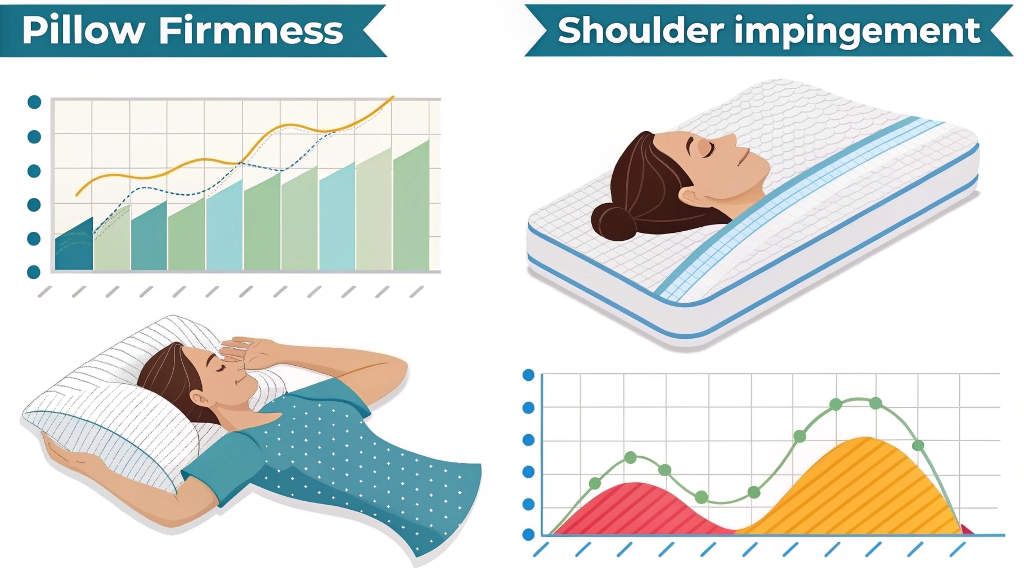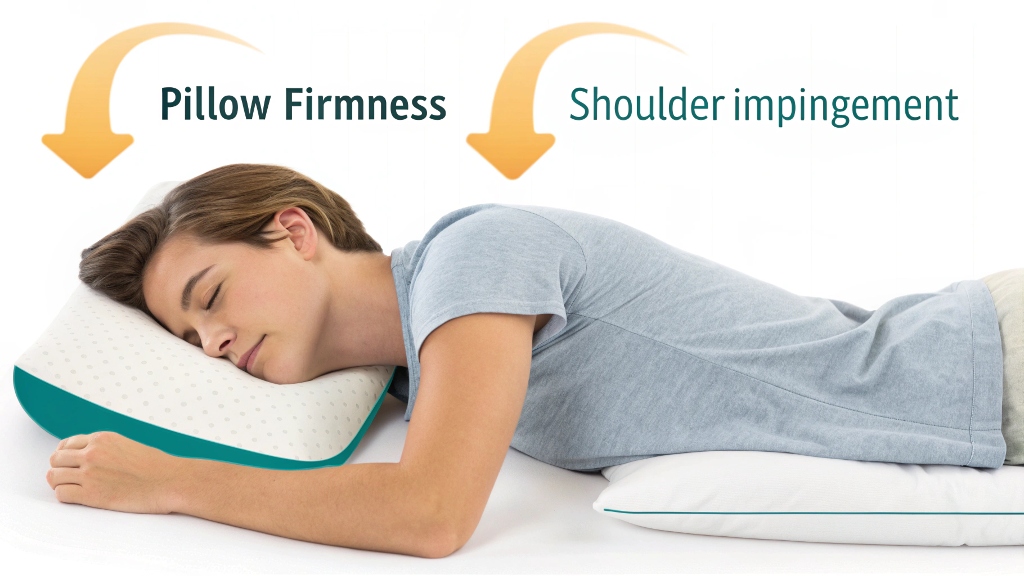The Hidden Link Between Pillow Firmness and Shoulder Impingement in Side Sleepers

If you sleep on your side and often wake up with shoulder pain, your pillow may be the reason. Many side sleepers unknowingly suffer from shoulder impingement due to poor pillow support. While mattress quality is important, the wrong pillow firmness can directly impact shoulder alignment and nerve pressure.
In my own experience, years of waking up with a numb arm and aching shoulder finally made me rethink my pillow choice. I’d been cycling through soft and extra-firm pillows, not realizing the toll it was taking on my posture. After switching to a medium-firm, contoured pillow, my shoulder discomfort improved dramatically within weeks.
Proper pillow firmness doesn’t just offer comfort—it plays a major role in spinal and shoulder health. Whether you’re an athlete, someone recovering from an injury, or just tired of tossing and turning, understanding how your pillow affects your shoulder is key.
And while you’re improving your rest, don’t forget the importance of outdoor comfort too. Take a moment to explore Peak Pillows to upgrade your lawn the same way you’re upgrading your sleep.
What Is Shoulder Impingement and Why Side Sleepers Are Vulnerable

Shoulder impingement is a condition where the tendons or bursa in your shoulder become compressed. This often causes inflammation, pain, and reduced mobility. For side sleepers, this condition can worsen if your pillow doesn’t support proper neck and shoulder alignment.
When lying on your side, the entire weight of your upper body presses into your shoulder. If your pillow is too soft, your head sinks too low. This compresses the shoulder joint further. On the other hand, if the pillow is too firm and high, your neck bends unnaturally, increasing tension in the rotator cuff.
According to a 2020 clinical review in BMJ Open Sport & Exercise Medicine, poor sleep posture is a leading cause of shoulder pain in middle-aged adults, especially in those with no prior injury. Side sleeping, while healthy for spinal alignment, needs specific pillow support to avoid joint stress.
A common question people ask is, why were pillows invented. Historically, pillows weren’t created just for comfort. They were designed to support the neck and promote proper spinal alignment.
Understanding your sleeping position and how your pillow affects joint alignment is the first step to preventing shoulder impingement.
How Different Pillow Firmness Levels Affect Side Sleepers
Choosing the right pillow firmness is more than a comfort preference—it’s a health decision. Each firmness level has a unique impact on the shoulder and spine for side sleepers.
Soft Pillows
Soft pillows often feel cozy at first but lack the structural support needed to hold the head in line with the spine. When you sleep on your side with a soft pillow, your head sinks, causing your shoulder to elevate unnaturally. This can:
- Compress the shoulder joint
- Increase tension on the rotator cuff
- Lead to nerve impingement and inflammation
Firm Pillows
Firm pillows maintain their shape and can support the head well. However, if they’re too thick, they can tilt your head upward, pulling the shoulder downward and straining the neck. Over time, this misalignment can lead to:
- Chronic neck stiffness
- Shoulder fatigue
- Tingling or numbness in the arm
Medium-Firm Pillows
A medium-firm pillow is the best choice for most side sleepers. It balances head elevation with shoulder relief. The support helps reduce pressure on the shoulder joint while maintaining spinal alignment. According to a study by the Journal of Manipulative and Physiological Therapeutics, medium-firm pillows showed the highest comfort and spinal alignment scores among side sleepers.
In summary, soft is too little, firm is often too much, and medium-firm hits the sweet spot.
Tips for Choosing the Right Pillow to Prevent Shoulder Impingement
Now that you understand the effects of pillow firmness, here’s how to choose the best pillow for side sleeping:
1. Choose the Right Loft
Loft refers to pillow height. For side sleepers, a medium to high loft (4–6 inches) is ideal. It fills the gap between your head and shoulder.
2. Consider Contoured or Cervical Pillows
These pillows are designed to cradle the head and support the neck. They help distribute weight evenly and reduce pressure on the shoulder joint.
3. Avoid Worn-Out Pillows
Over time, pillows lose their structure. Replace your pillow every 12–18 months or when you notice sagging. A lumpy or flat pillow won’t support you properly.
4. Test Before You Commit
If possible, try different pillow types in-store or through trial periods. Everyone’s body and shoulder width are different.
5. Use Additional Support
Placing a small pillow or folded towel under your arm can relieve pressure from the shoulder. It keeps your upper arm elevated and reduces internal rotation stress.
Making the right pillow choice doesn’t have to be overwhelming. Start by checking your current pillow and see how your shoulder feels in the morning.
My Journey from Shoulder Pain to Peaceful Sleep
Years ago, I was a chronic side sleeper with a soft down pillow. It felt luxurious but came with a hidden cost—daily shoulder pain. I ignored it at first, blaming stress or workouts. But it got worse, and soon even simple tasks like reaching for a cup caused discomfort.
One night, I propped a firmer pillow under my head and added a small towel roll under my arm. The result? A noticeable drop in shoulder tension. I finally invested in a medium-firm memory foam pillow with contour support. Within weeks, my pain decreased, and I stopped waking up stiff.
This isn’t just a theory—it’s personal. Sleep health is body health. You may not need a new mattress or therapy. Sometimes, a pillow change is all it takes.
Actionable Daily Habits to Reduce Shoulder Impingement
In addition to finding the right pillow, here are some daily habits to protect your shoulders:
Sleep Position Tweaks
- Switch sides during the night to balance shoulder pressure
- Avoid sleeping with your arm under your pillow, which compresses nerves
- Try hugging a body pillow to keep your upper arm supported
Daily Shoulder Stretches
Gentle stretching helps increase blood flow and relieve tension. A few to try:
- Pendulum stretch: Bend over slightly and swing your arm in circles
- Wall crawl: Use your fingers to slowly “walk” your arm up a wall
- Sleeper stretch: Lie on your side, arm out, and gently push it downward with the other arm
Strengthen Supporting Muscles
Weak shoulder muscles are more prone to injury. Add simple exercises like:
- Resistance band rows
- Shoulder blade squeezes
- Lateral raises
Building muscle support reduces the risk of future impingement.
Read More Also: Does a Coffee Grinder Make Instant Coffee? Unveiling the Truth
Final Thoughts
Shoulder impingement might start as a mild ache, but it can turn into a long-term issue if left unchecked. Side sleepers are especially at risk, but the right pillow can make a huge difference.
To recap:
- Avoid soft or over-firm pillows
- Aim for medium-firm, contour-supporting designs
- Choose a high-loft pillow to keep your spine and shoulder in line
- Replace pillows regularly
- Add daily stretches and exercises for best results
Your pillow may seem like a small detail, but its impact is big. Take the time to assess what you’re sleeping on—your shoulders will thank you.
Have you struggled with shoulder pain while sleeping? Found the perfect pillow for relief? Share your experience in the comments below and help others sleep better. And if you found this helpful, share it with a friend who sleeps on their side.
Read More Also: Empathy Activities for Kids: A Fun and Meaningful Guide
FAQs
What type of pillow is best for shoulder pain in side sleepers?
A medium-firm, high-loft pillow with contour support is ideal for reducing shoulder impingement in side sleepers.
How often should I replace my pillow to avoid shoulder pain?
Replace your pillow every 12 to 18 months, or sooner if it shows signs of sagging or lumpiness.
Can a pillow really cause shoulder impingement?
Yes. Poor pillow support can misalign the spine and compress the shoulder joint, increasing the risk of impingement.
Should I sleep on the injured shoulder or switch sides?
Avoid sleeping on the injured shoulder. Switch sides or sleep with support under your arm for better alignment.
Are body pillows helpful for shoulder impingement?
Yes. Hugging a body pillow keeps the upper arm elevated and aligned, reducing pressure on the shoulder joint.








